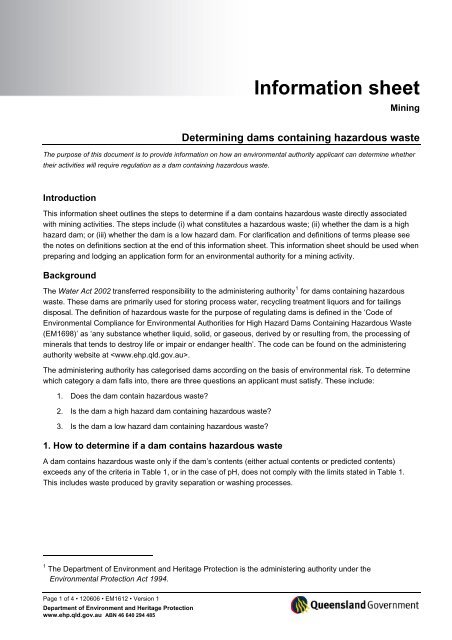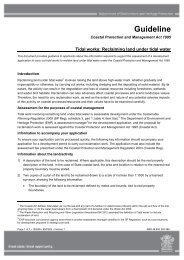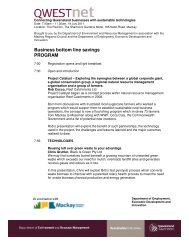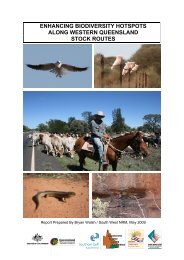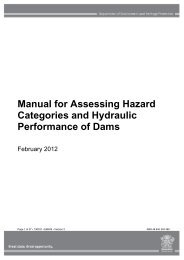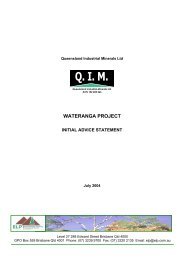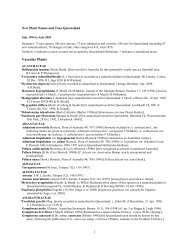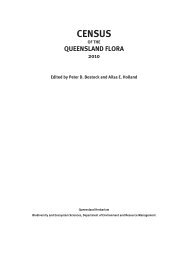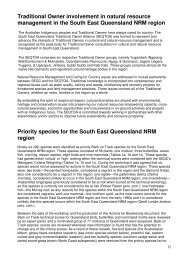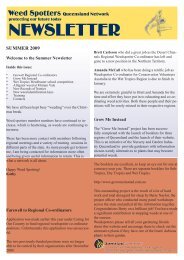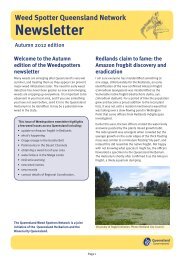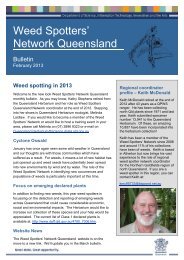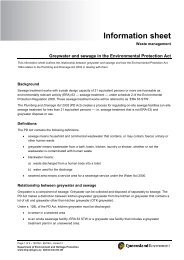Determining dams containing hazardous waste - EM1612 (PDF, 62K
Determining dams containing hazardous waste - EM1612 (PDF, 62K
Determining dams containing hazardous waste - EM1612 (PDF, 62K
You also want an ePaper? Increase the reach of your titles
YUMPU automatically turns print PDFs into web optimized ePapers that Google loves.
Page 1 of 4 • 120606 • <strong>EM1612</strong> • Version 1<br />
Department of Environment and Heritage Protection<br />
www.ehp.qld.gov.au ABN 46 640 294 485<br />
Information sheet<br />
Mining<br />
<strong>Determining</strong> <strong>dams</strong> <strong>containing</strong> <strong>hazardous</strong> <strong>waste</strong><br />
The purpose of this document is to provide information on how an environmental authority applicant can determine whether<br />
their activities will require regulation as a dam <strong>containing</strong> <strong>hazardous</strong> <strong>waste</strong>.<br />
Introduction<br />
This information sheet outlines the steps to determine if a dam contains <strong>hazardous</strong> <strong>waste</strong> directly associated<br />
with mining activities. The steps include (i) what constitutes a <strong>hazardous</strong> <strong>waste</strong>; (ii) whether the dam is a high<br />
hazard dam; or (iii) whether the dam is a low hazard dam. For clarification and definitions of terms please see<br />
the notes on definitions section at the end of this information sheet. This information sheet should be used when<br />
preparing and lodging an application form for an environmental authority for a mining activity.<br />
Background<br />
The Water Act 2002 transferred responsibility to the administering authority 1 for <strong>dams</strong> <strong>containing</strong> <strong>hazardous</strong><br />
<strong>waste</strong>. These <strong>dams</strong> are primarily used for storing process water, recycling treatment liquors and for tailings<br />
disposal. The definition of <strong>hazardous</strong> <strong>waste</strong> for the purpose of regulating <strong>dams</strong> is defined in the ‘Code of<br />
Environmental Compliance for Environmental Authorities for High Hazard Dams Containing Hazardous Waste<br />
(EM1698)’ as ‘any substance whether liquid, solid, or gaseous, derived by or resulting from, the processing of<br />
minerals that tends to destroy life or impair or endanger health’. The code can be found on the administering<br />
authority website at .<br />
The administering authority has categorised <strong>dams</strong> according on the basis of environmental risk. To determine<br />
which category a dam falls into, there are three questions an applicant must satisfy. These include:<br />
1. Does the dam contain <strong>hazardous</strong> <strong>waste</strong>?<br />
2. Is the dam a high hazard dam <strong>containing</strong> <strong>hazardous</strong> <strong>waste</strong>?<br />
3. Is the dam a low hazard dam <strong>containing</strong> <strong>hazardous</strong> <strong>waste</strong>?<br />
1. How to determine if a dam contains <strong>hazardous</strong> <strong>waste</strong><br />
A dam contains <strong>hazardous</strong> <strong>waste</strong> only if the dam’s contents (either actual contents or predicted contents)<br />
exceeds any of the criteria in Table 1, or in the case of pH, does not comply with the limits stated in Table 1.<br />
This includes <strong>waste</strong> produced by gravity separation or washing processes.<br />
1<br />
The Department of Environment and Heritage Protection is the administering authority under the<br />
Environmental Protection Act 1994.
Table 1 - Acceptance criteria<br />
Information sheet<br />
<strong>Determining</strong> <strong>dams</strong> <strong>containing</strong> <strong>hazardous</strong> <strong>waste</strong><br />
Parameter 2 Liquor 3 4 5<br />
Total solids<br />
Arsenic 1.0 mg/L 500 mg/kg<br />
Boron 5.0 mg/L 15 000 mg/kg<br />
Cadmium 10 µg/L 100 mg/kg<br />
Cobalt 1.0 mg/L 500 mg/kg<br />
Copper 1.0 mg/L 5 000 mg/kg<br />
Lead 0.5 mg/L 1 500 mg/kg<br />
Mercury 2 µg/L 75 mg/kg<br />
Nickel 1.0 mg/L 3 000 mg/kg<br />
Zinc 20 mg/L 35 000 mg/kg<br />
Chloride 2 500 mg/L —<br />
Fluoride 2.0 mg/L —<br />
Sulphate 1 000 mg/L —<br />
Cyanide 10 mg/L 2 500 mg/kg<br />
pH Between 4 and 8 Net acid generation of pH
Information sheet<br />
<strong>Determining</strong> <strong>dams</strong> <strong>containing</strong> <strong>hazardous</strong> <strong>waste</strong><br />
1. In the event of dam failure or overflow, the dam’s content would have one of the more of the following<br />
actions:<br />
a) flow to a sensitive or commercial place;<br />
b) flow to a riverine area <strong>containing</strong> permanent water;<br />
c) contaminate a water supply for human consumption; or<br />
d) contaminate a water supply for stock.<br />
2. The dam is located within a:<br />
a) declared catchment or sub artesian area; or<br />
b) watercourse and the dam’s surface area exceeds 1ha.<br />
3. The dam has a surface area greater than 2ha.<br />
3. How to determine a low hazard dam<br />
A low hazard dam is one that contains <strong>hazardous</strong> <strong>waste</strong>, poses a lower risk to the environment and<br />
consequently, the regulation is less rigorous than that of a high hazard dam.<br />
The dam <strong>containing</strong> <strong>hazardous</strong> <strong>waste</strong> is a low hazard dam if it does not fall within the category of a high hazard<br />
dam <strong>containing</strong> <strong>hazardous</strong> <strong>waste</strong>.<br />
Notes on definitions<br />
“commercial place” means a work place used as an office or for business or commercial purposes, which is<br />
not part of the mining activity and does not include employee’s accommodation or public roads.<br />
“dam failure” includes the uncontrolled release of the contents of a dam through collapse of the dam or some<br />
part of it, failure to prevent excessive seepage or failure to contain <strong>hazardous</strong> substances.<br />
“mining activities” refer to s. 147 of the Environmental Protection Act 1994.<br />
“sensitive place” means;<br />
a) a dwelling, residential allotment, mobile home or caravan park, residential marina or other<br />
residential premises;<br />
b) a motel, hotel or hostel;<br />
c) an educational institution;<br />
d) a medical centre or hospital;<br />
e) a protected area under the Nature Conservation Act 1992, the Marine Parks Act 1992 or a World<br />
Heritage Area; or<br />
f) a public park or gardens.<br />
“watercourse” means a river, creek, or stream in which water flows permanently or intermittently in a visibly<br />
defined channel (natural or artificially improved) with:<br />
a) continuous bed and banks;<br />
b) an extended period of flow for some months after rain ceases; and<br />
c) an adequacy of flow that sustains basic ecological processes and maintains biodiversity.<br />
Page 3 of 4 • 120606 • <strong>EM1612</strong> • Version 1 Department of Environment and Heritage Protection
Further information<br />
Advice and support are available:<br />
Information sheet<br />
<strong>Determining</strong> <strong>dams</strong> <strong>containing</strong> <strong>hazardous</strong> <strong>waste</strong><br />
� through a statewide network of regional offices of the administering authority and the Department of<br />
Natural Resources and Mines;<br />
on the administering authority website at ; and<br />
� by contacting Permit and Licence Management within the administering authority on 13 QGOV (13 74<br />
68).<br />
Disclaimer<br />
While this document has been prepared with care it contains general information and does not profess to offer<br />
legal, professional or commercial advice. The Queensland Government accepts no liability for any external<br />
decisions or actions taken on the basis of this document. Persons external to the Department of Environment<br />
and Heritage Protection should satisfy themselves independently and by consulting their own professional<br />
advisors before embarking on any proposed course of action.<br />
Page 4 of 4 • 120606 • <strong>EM1612</strong> • Version 1 Department of Environment and Heritage Protection


